The Power Rental Market is estimated to be valued at USD 11.5 billion in 2025 and is projected to reach USD 20.6 billion by 2035, registering a compound annual growth rate (CAGR) of 6.0% over the forecast period.
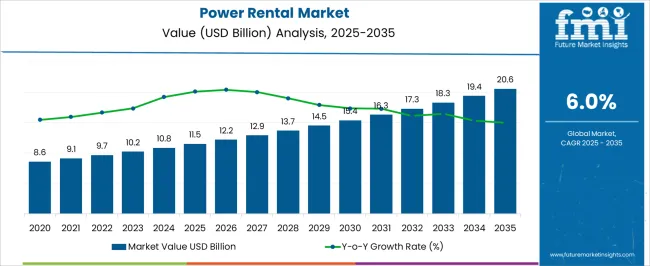
| Metric | Value |
|---|---|
| Power Rental Market Estimated Value in (2025 E) | USD 11.5 billion |
| Power Rental Market Forecast Value in (2035 F) | USD 20.6 billion |
| Forecast CAGR (2025 to 2035) | 6.0% |
The power rental market is expanding steadily due to increasing demand for temporary and scalable power solutions across critical industries. Unreliable grid infrastructure, rising frequency of natural disasters, and rapid industrialization in emerging economies are driving reliance on rental power systems.
Short term projects, emergency backups, and remote site operations require flexible and cost effective power alternatives, making rental equipment an essential part of operational planning. Additionally, growing infrastructure investments and rising data center construction are fueling demand for continuous and peak power support.
Technological enhancements in generator efficiency, emissions control, and remote monitoring are also contributing to market adoption. As industries shift toward asset light models and seek operational flexibility, the outlook for the power rental market remains strong with opportunities to scale across fuel types, power capacities, and end use sectors.
The market is segmented by Power Rating, Fuel, End Use, and Application and region. By Power Rating, the market is divided into <75 KVA, 75-375 KVA, 375-750 KVA, and >750 KVA. In terms of Fuel, the market is classified into Diesel, Gas, and Others. Based on End Use, the market is segmented into Telecom, Data Center, Health Care, Oil & Gas, Electric Utilities, Offshore, Manufacturing, Construction, Mining, Marine, and Others. By Application, the market is divided into Standby, Peak Shaving, and Prime/Continuous. Regionally, the market is classified into North America, Latin America, Western Europe, Eastern Europe, Balkan & Baltic Countries, Russia & Belarus, Central Asia, East Asia, South Asia & Pacific, and the Middle East & Africa.
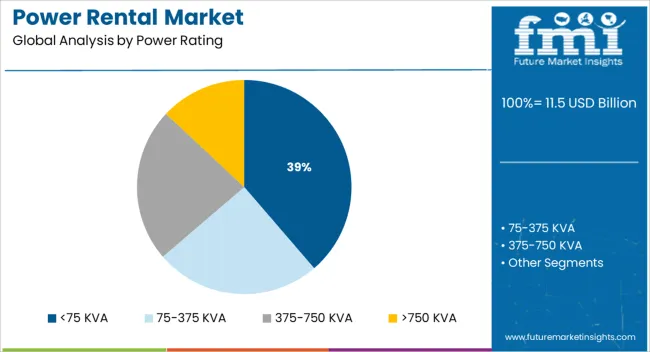
The below 75 KVA segment is expected to contribute 38.70% of total market revenue by 2025 within the power rating category, establishing it as the leading segment. This growth is being driven by high demand for compact and portable units suited for localized and small scale applications.
These generators are widely used across construction sites, small businesses, events, and temporary installations where lightweight and mobile solutions are prioritized. Their ease of transport, lower fuel consumption, and fast deployment make them ideal for urban and semi urban use.
As the market continues to cater to decentralized power needs, particularly in regions with inconsistent electricity supply, this segment remains dominant due to its operational versatility and affordability.
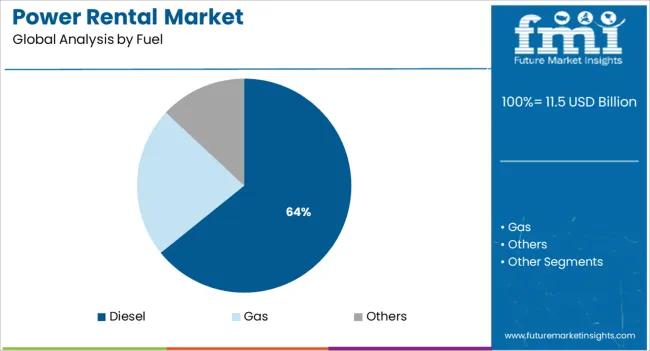
The diesel segment is projected to hold 64.20% of the total market revenue by 2025 under the fuel category, making it the most prominent fuel source. Its dominance stems from widespread availability, high energy density, and proven reliability in both prime and backup power applications.
Diesel generators are preferred in rugged and remote environments where consistent performance and long runtime are critical. Additionally, the established infrastructure for diesel distribution and the ability to support various load demands make it a go to option for rental fleet operators.
While alternative fuels are gaining attention, diesel remains the most dependable and scalable solution in the current rental landscape, especially in emergency and high load scenarios.
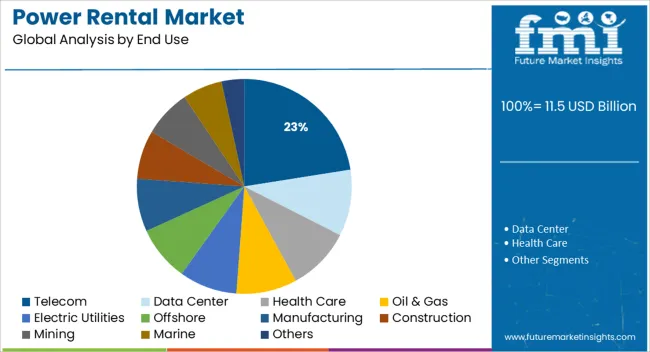
The telecom segment is anticipated to account for 22.50% of the total market revenue by 2025 within the end use category, positioning it as the top segment. This share is driven by the sector’s heavy reliance on uninterrupted power supply for network uptime and signal transmission.
Remote tower locations, particularly in off grid or low grid availability regions, require dependable backup systems to ensure service continuity. As telecom infrastructure expands with the rollout of 5G and increased rural connectivity efforts, rental power solutions offer a flexible and immediate response to site power requirements.
Compact generator sets are frequently deployed for both short term outages and long term infrastructure support, reinforcing the telecom sector’s leadership in the power rental market.
The global demand for power rental services is projected to increase at a CAGR of 6.0% during the forecast period between 2025 and 2035, reaching a total of USD 20.6 Billion in 2035, according to a report from Future Market Insights (FMI). From 2020 to 2025, sales witnessed significant growth, registering a CAGR of 3.2%. According to Future Market Insights, a market research and competitive intelligence provider, the Power Rental market was valued at USD 11.5 Billion in 2025.
The growth of the power generator rental market will be driven by increased demand for temporary electrical power sources during festivals, events, and fairs in the forthcoming years. These power systems offer peak shaving, allowing various businesses to accurately allocate their power use between non-peak and peak hours.
Global industrialization and the increasing need for dependable electricity supply are some major key trends that are projected to fuel market growth in the near future. The utility and industrial sectors have increased the demand for energy rental generators, owing to the smaller power grids and restricted access to the main transmission network. Additionally, factors such as the implementation of favorable government programs to expand metro and airport networks, as well as an increase in hotel and retail mall buildings, is also accelerating the demand for power rental in both established and growing economies.
Increasing Demand for Backup Power Solutions to Fuel the Market Growth
As nations are aggressively preventing themselves off of fossil fuels, the evolution towards renewable energy sources is assembling pace all over the globe, mainly from coal, to meet their energy needs. As a result, investments in renewable technologies have progressively developed in the last few years.
Renewables can sufficiently meet the demand for clean energy globally but an inherent disadvantage of renewables is that they are intermittent. Since energy storage technologies are still in promising stages of development. Thus, backup power solutions are essential for uninterrupted power supply to industries and households.
Power rental services and equipment can fill this gap because they are easy to access, require minimal maintenance, and are cost-effective. This is a major factor that is expected to fuel the growth of the Power Rental Market during the forecast period.
High Usage of Rental Power in the Mining Industry to Accelerate the Market Growth
The mining industry is one of the major end users of rental power. The mining sites are not attached to the grid, they rely on generator sets that have been engaged temporarily. The rental generators are in modest demand in industrial businesses, when there is a requirement for extra power during peak load demand, when the existing power supply system, such as purchased generator sets, has to be sustained, or when there is a brief outage.
As a result, the mining industry with poor grid power supplies is severely reliant on the power rental market. Hence, the mining industry is anticipated to boost the growth of the market during the forecast period.
Increased Operational Expenditure of Diesel Generators to Restrain the Market Growth
Diesel generator sets are considered to be one of the most popular backup power solutions for many end-users such as oil & gas, and manufacturing, owing to their quick start-up time, low initial investments, less space requirement, and ease of installation and operation.
However, diesel generator sets entail high operating costs, which is mainly on account of the high cost of fuel. Fuel costs account for over 80% of the total life cycle cost of a diesel generator set. This has made diesel a less cost-efficient solution for backup, especially in view of the drop in solar power prices. This is one of the major factors that is expected to hamper the growth of the power rental market during the forecast period.
Stringent Government Regulations to Limit the Market Growth
Stringent governmental norms have been imposed for diesel fuel globally to reduce emissions and meet environmental regulations. With growing environmental concerns each country has come up with its own set of regulations and policies to reduce air pollution. This is the major factor that is anticipated to restrain the market growth over the analysis period.
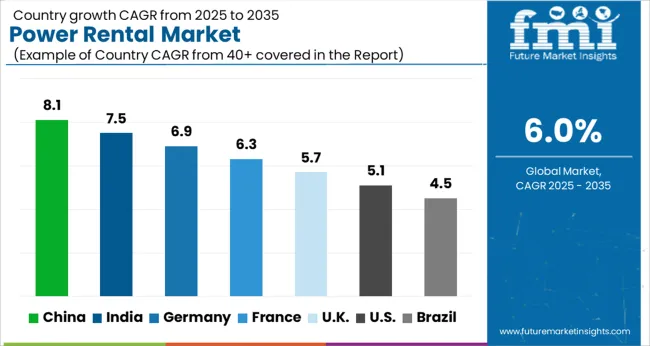
Increased Investments in Mining in the Region to Fuel the Market Growth
The Power Rental Market in North America is expected to accumulate the highest market share of 35% in 2025. North America is the most lucrative region along with the highest market share. Factors such as the rising investments in mining, construction, oil and gas, and related exploratory operations are projected to escalate the demand for the power rental market in North America.
The growing uncertainty of power supply provided by small-scale power grids, along with limited access to the essential transmission network, has raised the demand for rental generators in the utility and industries. In addition, there is a growing need for readily available rental equipment that can help overcome the issues associated with swells, voltage sags, and power outages.
Furthermore, favorable government initiatives to extend metro and airport networks, as well as the construction of hotels and shopping complexes, would raise demand for power renting in both existing and upcoming markets. Other factors to consider include rising renewables deployment and the utilization of natural gas-powered generators. The region is expected to hold a CAGR of 5.9% over the forecast period.
Increase in Construction Activities in the Region to Augment the Market Growth
The power rental Market in Asia Pacific is expected to accumulate a market share value of 33.2% in 2025. Currently, in Asia Pacific, China holds a significant market share by value in the global market. China is among the key countries for mining activities. China was also reported to hold more than a 20% share of the global mining industry in the year 2020. The manufacturing sector in China is also growing at an appreciable rate mainly driven by abundant raw material availability and economic labor costs.
Attributed to these factors, the demand for rental power is anticipated to remain high and the market in China is expected to hold a lion’s share of the global market. On the other hand, construction activities in the region are growing at steady rates in the region. All these factors are expected to boost regional market growth.
501 to 2,500 KW Segment to beat Competition in Untiring Market
On the basis of power rating, the global Power Rental market is dominated by 501-2,500 KW, which accounts for a share of 32%. This growth is attributed to the critical need for emergency power in heavy-duty applications. The segment is expected to hold a CAGR of 5.9% over the analysis period.
The generators with the power of 501 to 2,500 KW can be used to provide standby power as well as continuous power supply during outages peak shaving. Furthermore, developing countries face power outages more frequently than developed nations. This is due to poor transmission and distribution infrastructure as well as older power plants. To ensure that electricity is easily and reliably accessible to all industries, utility-scale power generation plants have been set up in some parts on a rental basis, which is driving the market.
Diesel Segment to Drive the Power Rental Market
Based on the Fuel, the diesel segment is expected to witness a significant growth of 30% in 2025, and the trend is expected to continue during the forecast period. Diesel generators are widely preferred by key players involved in the mining, oil and gas, and manufacturing sectors. The surplus availability and economical pricing of diesel fuel are among the key factors for the high demand for diesel generator sets for meeting temporary power demand. Moreover, regions such as Latin America, Asia Pacific, the Middle East, and Africa have a weak infrastructure for gas and liquefied petroleum gas pipelines, which adds to the growth in the demand for diesel generators in these regions.
However, regions such as Europe and North America are focused on reducing carbon emissions and are thus strengthening regulations related to the use of diesel. This is expected to retard the global diesel generator rental market growth marginally over the forecast period. The segment is expected to hold a CAGR of 5.8% over the analysis period.
Prominent players in the Power Rental market are Herc Rentals Inc., Atlas Copco, APR Energy Ltd., Generac Holdings, United Rentals Inc., Caterpillar Inc., Aggreko Plc., Ashtead Group Plc., Cummins Inc., Wacker Neuson, Kohler Co., Soenergy International, Bredenoord, Allmand Brothers Inc., and Multiquip, Inc., among others.
Recent Developments:
| Report Attributes | Details |
|---|---|
| Growth Rate | CAGR of 6.0% from 2025 to 2035 |
| Market Value in 2025 | USD 11.5 billion |
| Market Value in 2035 | USD 20.6 billion |
| Base Year for Estimation | 2025 |
| Historical Data | 2020 to 2025 |
| Forecast Period | 2025 to 2035 |
| Quantitative Units | Revenue in USD Billion and CAGR from 2025 to 2035 |
| Report Coverage | Revenue Forecast, Company Ranking, Competitive Landscape, Growth Factors, Trends, and Pricing Analysis |
| Segments Covered | Power Rating, Fuel, End-Use, Application, Region |
| Regions Covered | North America; Latin America; Europe; East Asia; South Asia & Pacific; Middle East and Africa (MEA) |
| Key Countries Profiled | USA, Canada, Brazil, Mexico, Germany, United Kingdom, France, Spain, Italy, China, Japan, South Korea, Malaysia, Singapore, Australia, New Zealand, GCC Countries, South Africa, Israel |
| Key Companies Profiled | Caterpillar Inc.; Cummins Inc.; Aggreko; Atlas Copco; Kohler-SDMO; Shenton Group; NIDS GROUP; Jassim Transport & Stevedoring Co. ; K.S.C.C.; Pump Power Rental; United Rentals; Sudhir Power Ltd.; Modern Hiring Service; Newburn Power Rental Ltd.; Global Power Supply; FG Wilson; ProPower Rental; APR Energy |
| Customization & Pricing | Available upon Request |
The global power rental market is estimated to be valued at USD 11.5 billion in 2025.
The market size for the power rental market is projected to reach USD 20.6 billion by 2035.
The power rental market is expected to grow at a 6.0% CAGR between 2025 and 2035.
The key product types in power rental market are <75 kva, 75-375 kva, 375-750 kva and >750 kva.
In terms of fuel, diesel segment to command 64.2% share in the power rental market in 2025.






Full Research Suite comprises of:
Market outlook & trends analysis
Interviews & case studies
Strategic recommendations
Vendor profiles & capabilities analysis
5-year forecasts
8 regions and 60+ country-level data splits
Market segment data splits
12 months of continuous data updates
DELIVERED AS:
PDF EXCEL ONLINE
Standby Power Rental Market Size and Share Forecast Outlook 2025 to 2035
Telecom Power Rental Market Size and Share Forecast Outlook 2025 to 2035
Compact Power Equipment Rental Market Growth - Trends & Forecast 2025 to 2035
Gas Fueled Power Rental Market Size and Share Forecast Outlook 2025 to 2035
Construction Power Rental Market Size and Share Forecast Outlook 2025 to 2035
Standby Gas Fueled Power Rental Market Size and Share Forecast Outlook 2025 to 2035
Prime Diesel Fueled Power Rental Market Size and Share Forecast Outlook 2025 to 2035
Peak Shaving Diesel Fueled Power Rental Market Size and Share Forecast Outlook 2025 to 2035
Power Grid Fault Prediction Service Market Size and Share Forecast Outlook 2025 to 2035
Power Plant Boiler Market Forecast Outlook 2025 to 2035
Power Ring Rolling Machine Market Size and Share Forecast Outlook 2025 to 2035
Power Supply Equipment for Data Center Market Size and Share Forecast Outlook 2025 to 2035
Power Electronics Market Size and Share Forecast Outlook 2025 to 2035
Power Quality Equipment Market Size and Share Forecast Outlook 2025 to 2035
Power Generator for Military Market Size and Share Forecast Outlook 2025 to 2035
Power Tools Market Size and Share Forecast Outlook 2025 to 2035
Power Supply Isolation Equipment Market Size and Share Forecast Outlook 2025 to 2035
Power Window Lift Motor Market Size and Share Forecast Outlook 2025 to 2035
Powered Surgical Staplers Market Size and Share Forecast Outlook 2025 to 2035
Power Distribution Component Market Size and Share Forecast Outlook 2025 to 2035

Thank you!
You will receive an email from our Business Development Manager. Please be sure to check your SPAM/JUNK folder too.
Chat With
MaRIA